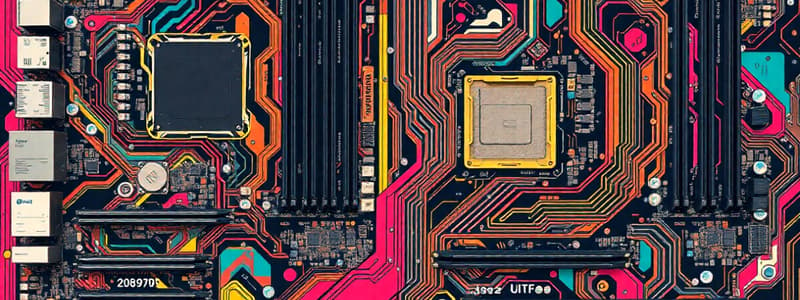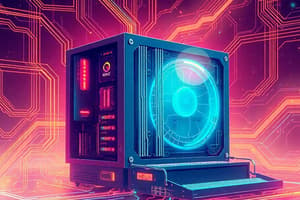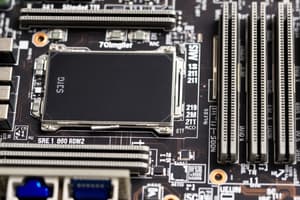Podcast
Questions and Answers
What is the primary function of the motherboard in a computer?
What is the primary function of the motherboard in a computer?
- To control the display settings
- To connect various components (correct)
- To store data permanently
- To manage power supply only
What determines the choice of motherboard size in a computer?
What determines the choice of motherboard size in a computer?
- The color of the computer casing
- The form factor of the case (correct)
- The user interface design
- The speed of the internet connection
Which component is generally NOT found on a motherboard?
Which component is generally NOT found on a motherboard?
- CPU
- Expansion slots
- Power connector
- Hard drive (correct)
Which aspect of motherboards does NOT typically vary across different models?
Which aspect of motherboards does NOT typically vary across different models?
What is the primary reason for choosing a motherboard based on airflow considerations?
What is the primary reason for choosing a motherboard based on airflow considerations?
Which of the following is NOT a common reason for selecting a specific motherboard?
Which of the following is NOT a common reason for selecting a specific motherboard?
In terms of motherboard types, which statement is most accurate?
In terms of motherboard types, which statement is most accurate?
What is the role of expansion slots on a motherboard?
What is the role of expansion slots on a motherboard?
What is the primary advantage of using an ATX motherboard?
What is the primary advantage of using an ATX motherboard?
In what scenario would a Mini-ITX motherboard be the best choice?
In what scenario would a Mini-ITX motherboard be the best choice?
What was a significant development year for the ATX motherboard standard?
What was a significant development year for the ATX motherboard standard?
Which statement correctly describes the ITX motherboard?
Which statement correctly describes the ITX motherboard?
What is a typical feature of the ASUS Maximus VII Hero ATX motherboard?
What is a typical feature of the ASUS Maximus VII Hero ATX motherboard?
What is a common application for a Mini-ITX motherboard?
What is a common application for a Mini-ITX motherboard?
Why would someone choose a smaller motherboard over a standard ATX motherboard?
Why would someone choose a smaller motherboard over a standard ATX motherboard?
What distinguishes the ATX form factor from Mini-ITX?
What distinguishes the ATX form factor from Mini-ITX?
Flashcards
ATX (Advanced Technology Extended)
ATX (Advanced Technology Extended)
A motherboard form factor that's been the standard for desktop computers since 1995. It offers ample space for expansion and memory, along with multiple expansion slots.
ITX (Intel Tiny)
ITX (Intel Tiny)
A motherboard form factor optimized for smaller devices, often used in media centers, thin clients, or custom builds where space is limited.
Mini-ITX
Mini-ITX
A type of ITX motherboard, known for its compact size and suitability for very small form factor computers.
Motherboard Form Factor
Motherboard Form Factor
Signup and view all the flashcards
Expansion slots
Expansion slots
Signup and view all the flashcards
CPU socket
CPU socket
Signup and view all the flashcards
Memory slots
Memory slots
Signup and view all the flashcards
Power connector
Power connector
Signup and view all the flashcards
Motherboard
Motherboard
Signup and view all the flashcards
Motherboard Size
Motherboard Size
Signup and view all the flashcards
Motherboard Power Connector
Motherboard Power Connector
Signup and view all the flashcards
Choosing a Motherboard Size
Choosing a Motherboard Size
Signup and view all the flashcards
Motherboard Components
Motherboard Components
Signup and view all the flashcards
Motherboard Installation
Motherboard Installation
Signup and view all the flashcards
CompTIA Motherboard Focus
CompTIA Motherboard Focus
Signup and view all the flashcards
Study Notes
Motherboard Types and Sizes
- Motherboards are the fundamental components of computers.
- They house the CPU, memory slots, power connections, and expansion slots.
- Motherboard sizes vary based on system requirements.
- Popular sizes include ATX and ITX.
Motherboard Features
- Basic layout generally consistent across different sizes (CPU, memory, expansion slots).
- Expansion and memory slots vary by size.
- Power connectors are standardized, ensuring compatibility.
- Motherboard choice influenced by case size, required expansion, and cooling needs.
- Many types exist; however, only a few are popular.
ATX Motherboards
- ATX is a popular desktop computer motherboard type.
- It provides ample space for expansion slots and memory.
- ATX standard has been around since 1995.
- Significant updates to ATX standard in recent years.
- Common ATX motherboards today feature 20 or 24-pin power connectors and additional CPU power.
ITX Motherboards
- ITX motherboards offer a smaller form factor, perfect for smaller cases.
- Created by VIA Technologies in 2001.
- ITX motherboards have the same screw holes as ATX, allowing installation in larger cases to a degree.
- Small size allows for use in small areas (e.g., media center).
Choosing a Motherboard
- CompTIA exam objectives focus on selecting appropriate motherboards for specific tasks (e.g., media center, video editing, thin client).
- Exam questions typically require choosing between a few motherboard types.
- Understanding motherboard sizing is important for various uses.
Studying That Suits You
Use AI to generate personalized quizzes and flashcards to suit your learning preferences.



